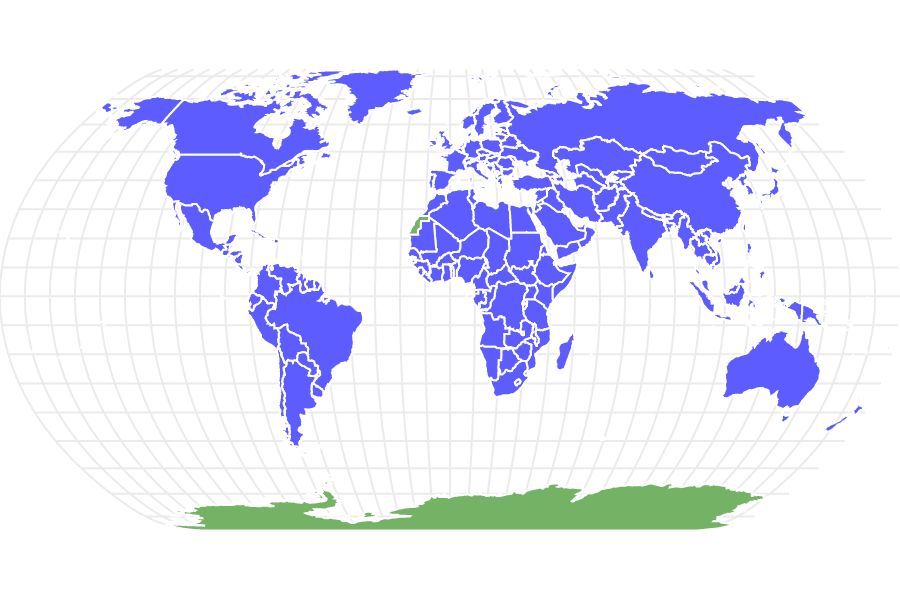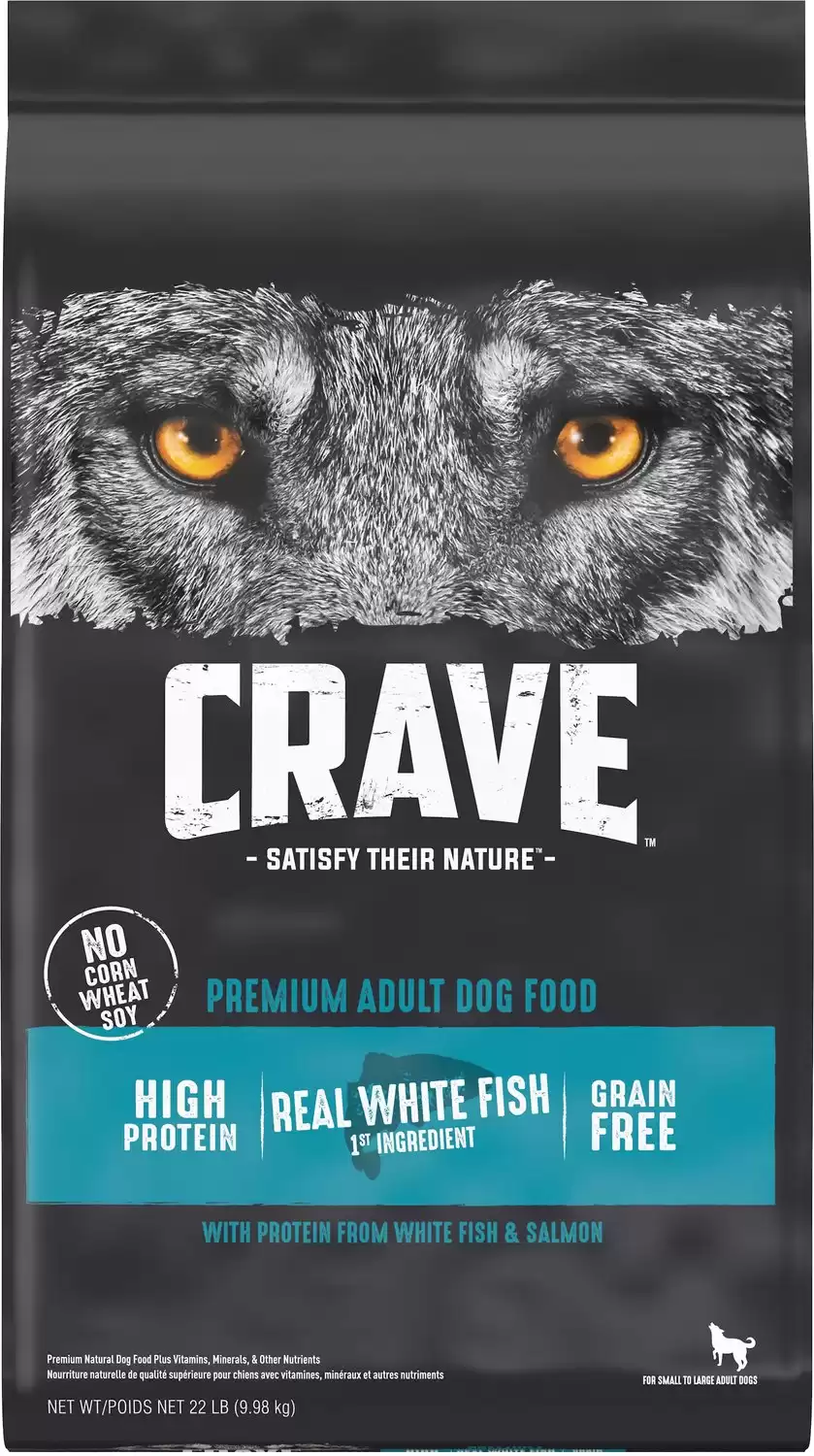Mongrel
Canis Lupus
Mongrels often suffer from few health issues and live longer than purebreds.
Advertisement
Mongrel Scientific Classification
- Kingdom
- Animalia
- Phylum
- Chordata
- Class
- Mammalia
- Order
- Carnivora
- Family
- Canidae
- Genus
- Canis
- Scientific Name
- Canis Lupus
Read our Complete Guide to Classification of Animals.
Mongrel Conservation Status
Mongrel Facts
- Slogan
- Has characteristics of two or more breeds!
Mongrel Physical Characteristics
- Skin Type
- Hair
Mongrel as a Pet:
- General Health
- Energy Level
- Shedability
- Trainability
- Intelligence
- Tendency to Chew
- Size
- Family and kid friendliness
- Yappiness / Barking
- Moderate
- Separation Anxiety
- Moderate
- Preferred Temperature
- Average climate
- Exercise Needs
- Moderate
- Friendly With Other Dogs
- Moderate
- Pure bred cost to own
- $250-$1000
- Dog group
- Sporting
- Male weight
- 5-170 lbs
- Female weight
- 5-140 lbs
This post may contain affiliate links to our partners like Chewy, Amazon, and others. Purchasing through these helps us further the A-Z Animals mission to educate about the world's species.
View all of the Mongrel images!
A mongrel results from the unintentional breeding of two dogs.
Mongrels, also known as mutts, are mixed-breed dogs. Unlike ‘designer’ mixed breeds, such as Golden Doodles, Cockapoos, or Puggles, a mongrel results from the unintentional breeding of two dogs. It is estimated that there are about 150 million mongrels around the globe.
See all of our expert product reviews.
Many people prefer adopting a mongrel over purchasing a purebred from a breeder. They are significantly less expensive than the price you’d pay for a purebred and often have fewer health issues because of less inbreeding. The personality and temperament of a mongrel can vary depending on the breeds that are included in their genetic makeup. If you are unsure of a mongrel’s bloodlines, this can make it more of a challenge to guess what their temperament may be.
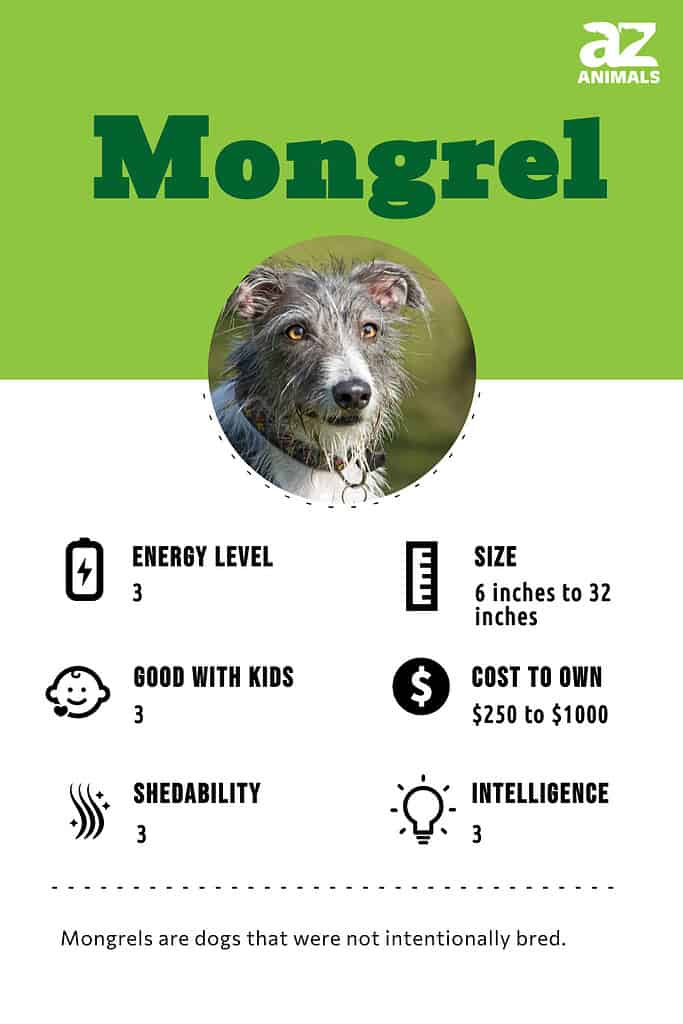
3 Pros And Cons Of Owning A Mongrel:
| Pros! | Cons! |
| Unique look: Mongrels can have a very individual and cute appearance based on the mix of different traits from the various breeds included in their makeup. | Less predictable behavior: Without knowing the mix of breeds in a mutt, it can be more challenging to anticipate their temperament and behavior. This can be especially troublesome for families with children. |
| Fewer health issues: Mongrels are often less prone to some health concerns since there isn’t as much inbreeding as you find with purebreds. | Unknown size: If you purchase a mongrel puppy, you may not be able to predict their full-grown size and could end up with a larger dog than you’re ready for. |
| Less expensive: Mongrels cost less to adopt than purchasing a purebred from a groomer. | Unknown appearance: You may also not be able to predict the appearance of an adult mongrel based on their appearance as a puppy. |
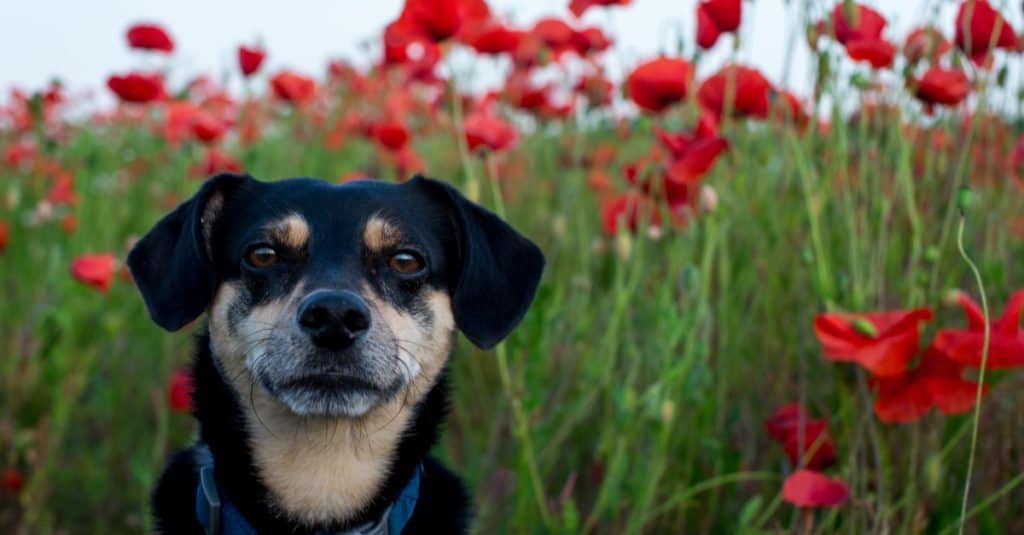
You never know what a Mongrel will look like as it gets older. Being of mixed breed, different features may come out as your dog gets older.
©Quisquilia/Shutterstock.com
History Of The Mutt
As the mongrel, or mutt, has been around just as long as purebred dogs, it is believed that they date back to very ancient times although each dog has a different history, as they all have a different lineage. A dog that is a mix of chihuahua, Pekingese, and Cavalier King Charles will not have the same ancient lineage as a dog that is a blend of labrador and spaniel.
Types Of
Because a mongrel is an unintentional mix of multiple dogs and does not belong to one specific breed, there is an infinite number of how many types of mongrels there can be. It is believed that there are over 150 million different mongrels throughout the world and since there is no definitive breed of parentage for every dog, it is hard to pinpoint each type of dog.
Health and Entertainment for your Mongrel
See all of our expert product reviews.
Size And Weight
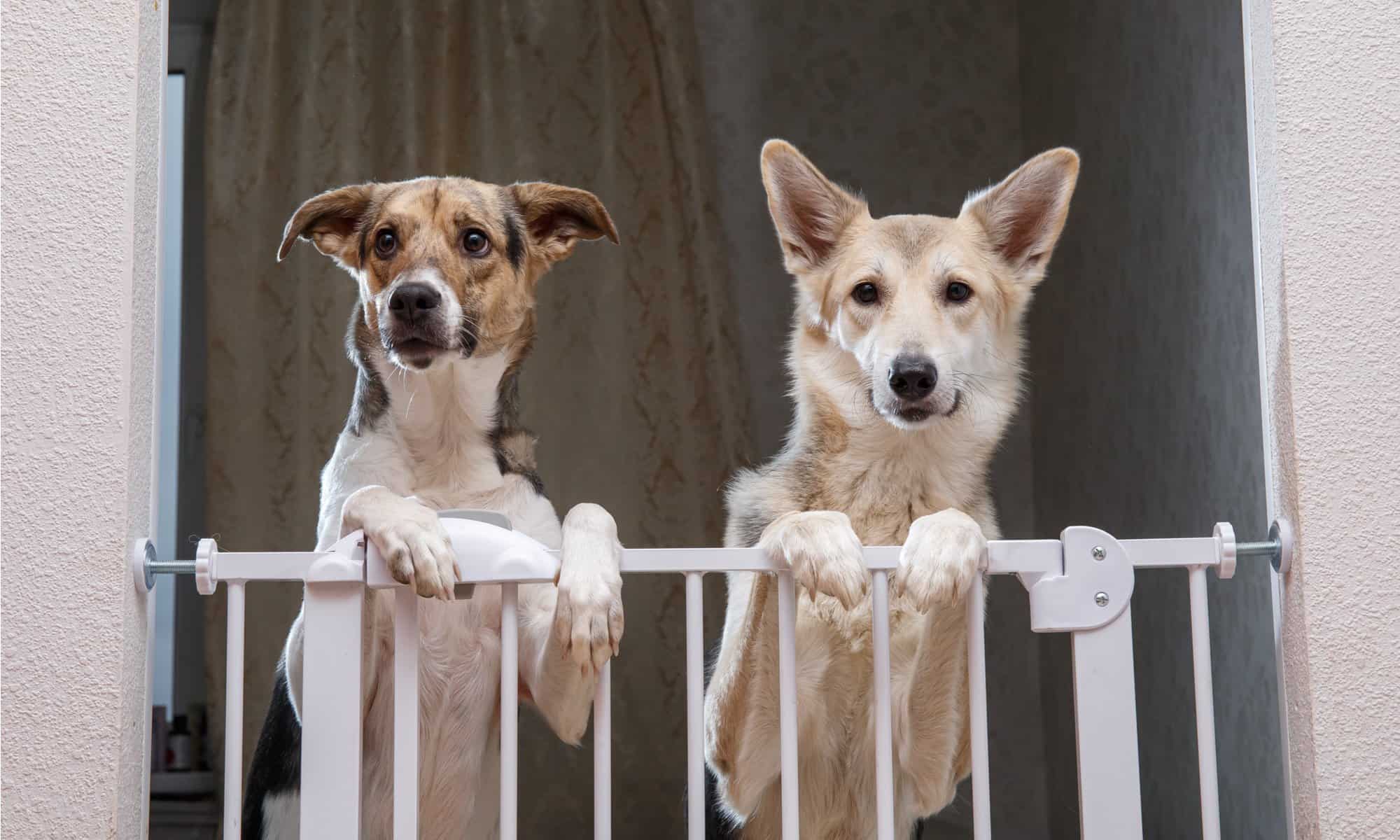
Each mongrel dog will be a different size and weight, depending on which breeds it was mixed with.
©Alex Zotov/Shutterstock.com
Since Mongrels feature a mix of different breeds, their size and weight can vary greatly. Mongrels that are a mix of two larger breed dogs, will likely be larger, and mongrels that are mixed from smaller breed dogs will likely be smaller in size. However, many Mongrels include a large mix of dog breeds and their size can vary a lot.
You can use the size of the feet of a Mongrel puppy to try to predict their full-grown size. Puppies with feet that look overly large for their body will end up being larger, whereas puppies that look more proportional in relation to their body will likely end up being a smaller or medium-sized dog. In general, dogs are about two-thirds of their full-grown size by the time they are four months old, so this can also help you predict the final weight a Mongrel will reach.
| Height (Male): | 6 inches to 32 inches |
| Height (Female): | 6 inches to 32 inches |
| Weight (Male): | 5 pounds to 170 pounds |
| Weight (Female): | 5 pounds to 140 pounds |
Common Health Issues

While mongrel dogs may generally be healthier, they still do have health issues.
©iStock.com/Aleksandr Zotov
Since the genetic makeup of a Mongrel is unknown, the breed-specific health issues they may suffer from are also a mystery. There are, however, a few health concerns that are common among all breeds that you should be aware of before you adopt a mutt.
Some Mongrels, like humans, will develop cancer as they age. Depending on the severity and location of the cancer, your veterinarian may be able to provide treatment or give your mutt surgery to remove cancerous cells.
Heartworm is also common among Mongrels. Since it can be prevented with monthly treatments, be sure to speak with your vet about starting your mongrel on a heartworm medication.
If you adopted your mongrel from a shelter, it may have kennel cough. Mongrels with kennel cough will need rest, food, and water to help them recover. In more severe cases, your veterinarian may prescribe an antibiotic.
In summary, a few of the possible health issues mongrels may suffer from include:
- Cancer
- Heartworm
- Kennel cough
Temperament And Behavior
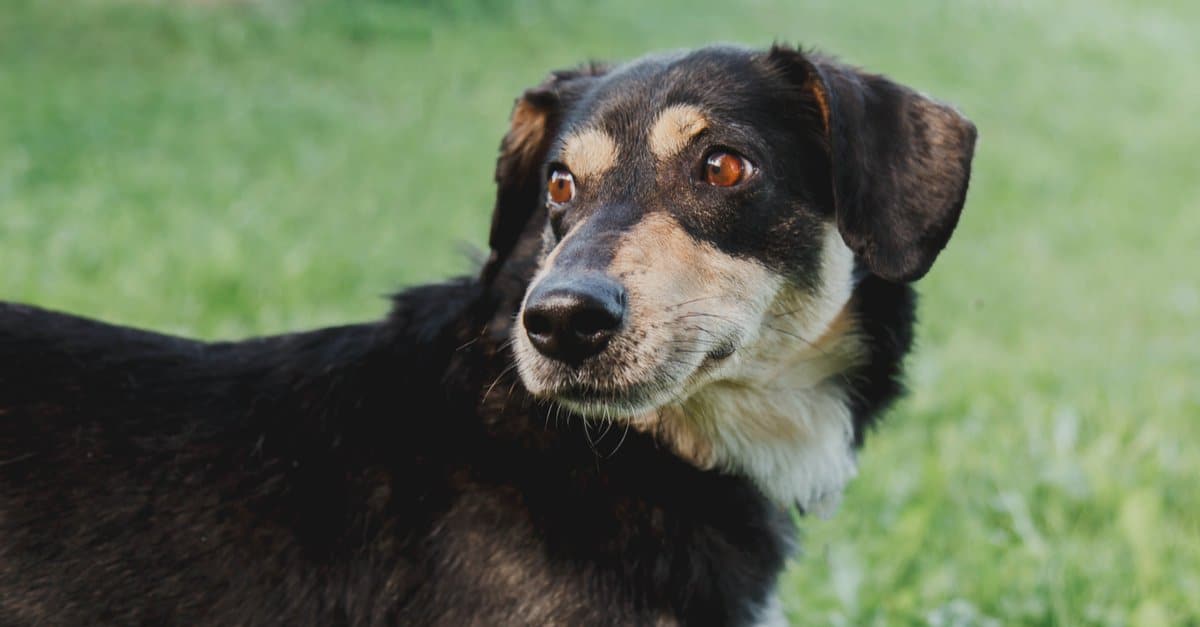
Mongrels can vary from docile to aggressive depending on their bloodline and their upbringing.
©Evgeniia Primavera/Shutterstock.com
A Mongrel’s temperament is not as easily predicted as that of a purebred. Each breed of purebred shares some common personality traits, which can give owners a clue about the personality and behaviors they can expect from their dog. Mutts are less predictable since you won’t know the genetic makeup of your Mongrel and which traits will come out stronger in your specific pup. Mixed-breed dogs can end up being very sweet and even-tempered, high-energy and aggressive, or anywhere in the middle. This guessing game often means that your dog may not be the best choice for homes with young children where a child-friendly pet is a must.
How To Take Care Of A Mongrel
Each Mongrel will be unique, so you will want to work closely with your veterinarian to determine the type of care your dog needs. Once you’ve owned your Mongrel for a while, you will begin to learn more about his temperament, activity needs, and attention needs and can use this information to offer the best possible care.
The Best Dog Food For Mongrels
One of the best perks of owning a Mongrel or ‘Mutt’ is eliminating most of the worst health problems that can plague purebreds and ‘designer’ dogs and shorten their lifespan.
But just because you don’t own a fancy breed doesn’t mean you don’t want to treat your dog to top-tier nutrition. Mongrel owners usually can’t go wrong with CRAVE Grain Free High Protein Adult Dry Dog Food, White Fish & Salmon.
As the main ingredient, real meat and fish provide protein for lean muscle for dogs of all sizes. This grain-free food can be more easily digestible and cuts out the artificial additives that are linked to so many health complications like cancer.
Click here for Crave Grain Free High Protein Adult Dry Food.
- Grain free white fish high protein recipe
- No corn, wheat, soy, artificial flavors, colors, or preservatives
- Provides energy and promotes immune health
The amount of food that your pet will need will vary based on his size, activity level, and age, and the type of food you feed him or her. Check with your veterinarian to determine the best type of food and the appropriate amount for your mongrel. Most Mongrels do best when they are offered two meals each day. Here are some general guidelines to keep in mind based on the weight of your mutt.
- 3 to 12 pounds: 1/3 to 1 cup of dry food
- 13 to 20 pounds: 1 to 1 1/3 cup of dry food
- 21 to 35 pounds: 1 1/3 to 2 cups of dry food
- 26 to 50 pounds: 2 to 2 2/3 cups of dry food
- 51 to 75 pounds: 2 2/3 to 3 1/3 cups of dry food
- 76 to 100 pounds: 3 1/3 to 4 ¼ cups of dry food
- Over 100 pounds: 4 ¼ cup plus ¼ cup for each additional 10 pounds of weight over 100 pounds
Keep in mind that puppies have a smaller stomach than adults, so a Mongrel puppy will need to eat three or four smaller meals throughout the day. By the time most puppies are six months old, they should generally be fine with just two meals. Look for high-quality puppy food for your puppy.
Maintenance And Grooming

Grooming varies based on each dog but trimming nails and brushing teeth regularly on all mongrels is recommended.
©Mary Swift/Shutterstock.com
Again, the amount of maintenance and grooming your mongrel will need will vary based on the mix of breeds in their DNA. Longer-haired dogs will require at least weekly brushing, and many shorter-haired dogs also do best with regular brushing to keep their coat looking nice. If you notice that your Mongrel’s coat is shedding a lot or getting tangled, increase the number of times you brush them each week. If their coat is unmanageable or too long, you can consider bringing them to a professional groomer every few months.
Your dog will also need his or her teeth brushed a few times each week. Be sure to keep their nails trimmed so they don’t get too long and make it painful to walk. Keeping your pet’s ears clean is also important; if too much wax builds up or too much debris gets in their ears, it can lead to ear infections.
Training
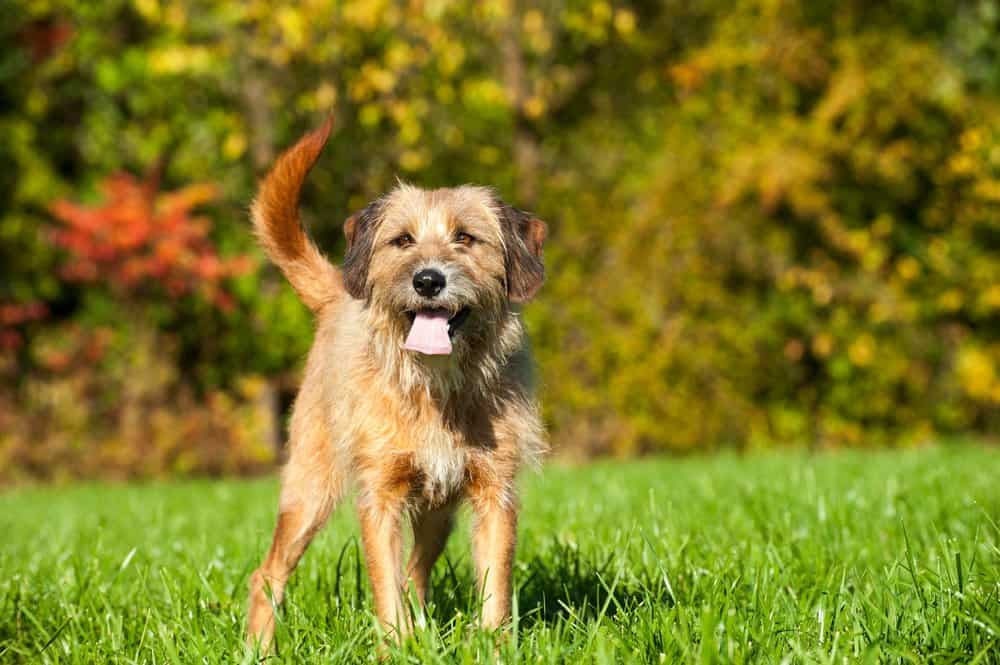
The training process should begin as soon as your mongrel dog is brought home.
©Dora Zett/Shutterstock.com
While you won’t know the exact personality of your Mongrel, it is always a good idea to begin the training process once you bring a puppy or adult mutt home. Start socializing your dog and look to sign up for obedience classes to help them learn how to follow commands and act appropriately in different situations. Most dogs respond best to positive training methods, so keep this in mind as you are training your Mongrel.
Exercise
The amount of exercise your mutt will need will also vary based on their genetic makeup, but all dogs need daily activity. Aim to take your pup for a daily walk and provide them space to run and play in a fenced-in backyard. If your dog seems overly energetic or becomes destructive, it may be an indication that they are not getting enough exercise, so you should aim to increase the amount they get each day.
Puppies
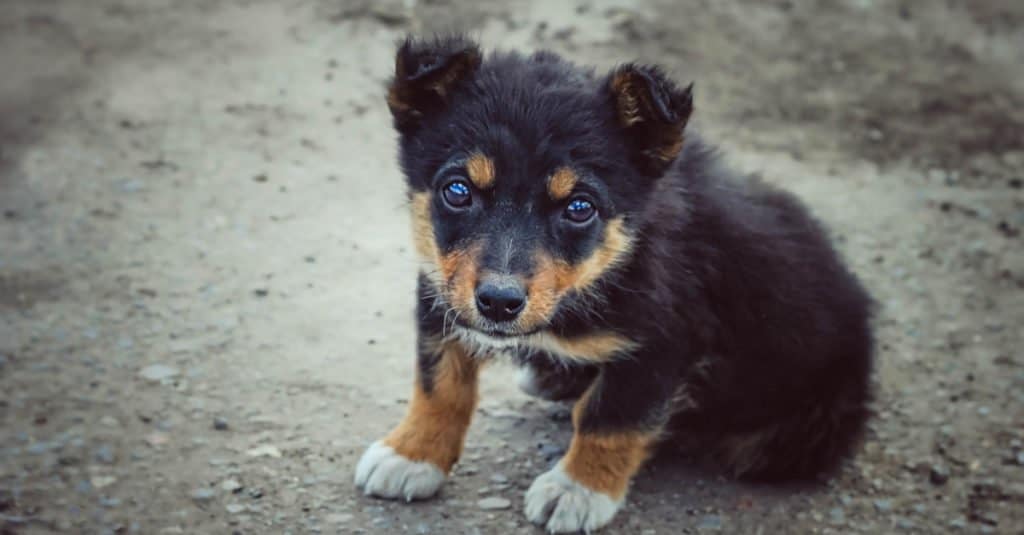
Mongrel puppies often have an unknown temperament since they are a mixed breed.
©ju_see/Shutterstock.com
All puppies, regardless of their genetic makeup, will need a safe environment free of anything that could potentially cause them harm. Before bringing home a Mongrel puppy, inspect your space to make sure it is safe for them. Remove anything potentially hazardous. Puppies, in general, are also known for chewing on things, so be sure to pick up and put any of your personal items that you wouldn’t want to see destroyed by a puppy.
Mongrel puppies will need food, a crate, a bed, a leash and collar, toys, treats, and other supplies. Be sure to purchase all of these materials before you bring home your puppy so that you are prepared and everything is set up.
Mongrels And Children
As we shared above, a Mongrel’s personality is less easy to predict than purebreds. For this reason, adopting a mongrel puppy may not be ideal for homes with children, especially younger children. If you’re adopting an older Mongrel from someone who can reliably let you know what their personality is like, they could be a good fit for homes with children.
Dogs Similar To Mongrels
Identifying dogs similar to mongrels can be challenging since mongrels can be made up of any dog breed. Below are a few common breeds that may be mixed into some mongrels you’ll find.
- Labrador Retriever: Labrador retrievers are a very friendly and easy-going breed. They are great around children and are also commonly selected for use as a service dog. Labrador Retrievers are also very active and have high exercise needs.
- German Shepherd: German Shepherds are very intelligent dogs. They are easier to train than many other breeds because of their eager-to-please nature. However, German Shepherds have a high need for activity and attention and may become destructive if these needs aren’t met.
- Bulldog: Bulldogs are a muscular, medium-sized breeds. They are very friendly and do well with children. They can also be stubborn and challenging to train.
Famous Mongrels
Some mutts have made the big time and been in a variety of movies and TV shows. Here are a few famous Mongrels:
- Buster from the movie Bruce Almighty was a Mongrel.
- Lucky from the movie Dr. Doolittle was a Mongrel.
- Duke from the movie Bad Boys was a Mongrel.
- Sweeties from the movie Diary of a Wimpy Kid: Dog Days was a Mongrel.
Popular Names For Mongrel
Looking for the name that best suits your mutt? Check out the list below for some great ideas:
- Max
- Duke
- Jack
- Olive
- Bentley
- Bella
- Penny
- Ellie
- Daisy
- Molly
Mongrel FAQs (Frequently Asked Questions)
Are Mongrels herbivores, carnivores, or omnivores?
Mongrels are Omnivores, meaning they eat both plants and other animals.
What Kingdom do Mongrels belong to?
Mongrels belong to the Kingdom Animalia.
What class do Mongrels belong to?
Mongrels belong to the class Mammalia.
What phylum to Mongrels belong to?
Mongrels belong to the phylum Chordata.
What family do Mongrels belong to?
Mongrels belong to the family Canidae.
What order do Mongrels belong to?
Mongrels belong to the order Carnivora.
What genus do Mongrels belong to?
Mongrels belong to the genus Canis.
What type of covering do Mongrels have?
Mongrels are covered in Hair.
What is an interesting fact about Mongrels?
Mongrels have characteristics of two or more breeds!
What is the scientific name for the Mongrel?
The scientific name for the Mongrel is Canis Lupus.
How much does Mongrel cost to own?
Mongrels are not a purebred and will cost significantly less than purchasing a dog from a breeder. The price to adopt a Mongrel from a shelter or rescue organization is generally around $250 or less.
You will also want to budget enough money to cover the rest of the care and food your mongrel will need after you adopt him or her. The first year you own the mongrel will likely be the most expensive, and you’ll want to budget between $1,000 and $1,500 to cover all the expenses. The following years should be less expensive, but still, be sure to budget between $500 and $1,000 to make sure you can cover everything your mutt needs.
Are Mongrel's good with kids?
Mongrels can be good with kids, but some are not. Since the personality of a Mongrel is more challenging to predict, it may be best for families with younger children to choose a breed with a more predictable temperament.
How long does Mongrel live?
Mongrels generally live longer than purebreds. The average lifespan of a mongrel is typically between 10 and 13 years, but this can vary based on a lot of factors such as their genetic makeup and their overall health.
What is a Mongrel?
The definition of a Mongrel is a mixed breed dog that was not intentionally bred.
Is a Mongrel a specific breed of dog?
No, a Mongrel is not a specific dog breed. They are a mix of two or more (often many more breeds).
What does it mean when you call a dog a mutt?
Mutts, by definition, are Mongrels. They are the result of unintentional breeding and are made up of a mix of different breeds.
Thank you for reading! Have some feedback for us? Contact the AZ Animals editorial team.
Sources
- David Burnie, Dorling Kindersley (2011) Animal, The Definitive Visual Guide To The World's Wildlife
- Tom Jackson, Lorenz Books (2007) The World Encyclopedia Of Animals
- David Burnie, Kingfisher (2011) The Kingfisher Animal Encyclopedia
- Richard Mackay, University of California Press (2009) The Atlas Of Endangered Species
- David Burnie, Dorling Kindersley (2008) Illustrated Encyclopedia Of Animals
- Dorling Kindersley (2006) Dorling Kindersley Encyclopedia Of Animals

